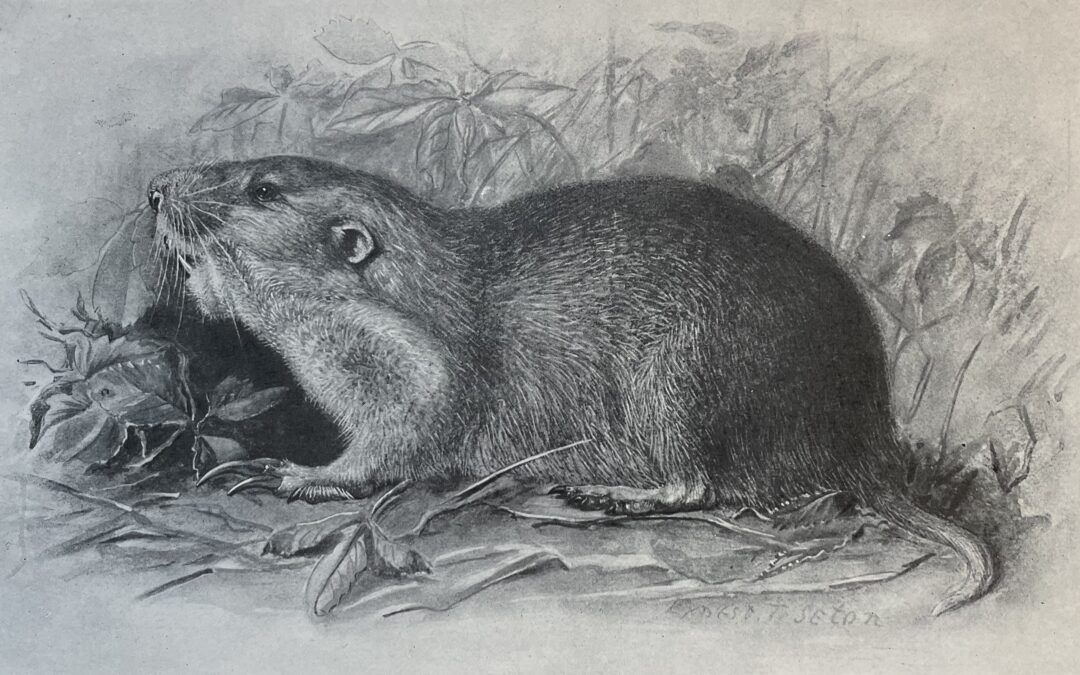Pocket Gopher by Ernest Thompson Seton 1892
Seton was the first to publish that in some places the Pocket Gopher provides a service practiced elsewhere by earthworms: aeration of the soil. (He devoted many pages of Life-Histories of Northern Animals to this subject; it was among his early firsts as a scientist.) Sometimes they provide this service in my garden while destroying (eating) prized plantings. Me to Pocket Gophers: aerate the soil somewhere else. There are several species; the one Seton focused on ranges from western Canada to northern New Mexico. I couldn’t find evidence that the Geomyidae are at risk, although individuals may meet their end from predators or angry gardeners. According to Seton:
CHILD OF THE DARK WORLD
“The Gopher lives the life of a mole, living in a burrow which is about 3 inches wide and ramified indefinitely near the surface. It throws up a mound every few feet, but in some cases a gallery is run for 20 or 30 feet without a mound appearing.
Its method of burrowing, as observed in captive specimens, is to loosen the earth with powerful front claws, as it stands with hind-feet advanced and wide spread, then throw it backward between the hind-legs, to be further passed on by the hind-feet; and when a sufficient pile is ready, the Gopher turns round and pushes with its broad head and powerful front-feet, forcing the pile ahead of it to the first side gallery, up that and out, usually without exposing itself. The earth is always moved thus, not in the enormous cheek pouches, as some believe. (Pg. 568)
One of the most curious characteristics of its fore-paws is their perfect prehensileness. This is attained, not by a true digital prehensility, but by the long claws working against the large pad of cushion of the pisiform region, as is the case with the sloth and some other animals. This power seems of use only in handling food, while foraging, eating, or filling their pockets.” (Pg. 569)
TOAD HALL
“In Manitoba and New Mexico I have several times found Gophers with an interesting kind of companion or semi-parasite. Amphibians of the genus Ambystoma commonly take refuge for the winter in the Gopher tunnels.
The common toad, also will avail himself of the easy digging furnished by the new Gopher mound, when the time comes to bury himself for the season.” (Pg. 572)
{Ed. Note: In September 2024 I thought I saw a toad diving into a Mendocino County gopher hole; I doubted the accuracy of that observation before reading this section by Seton. Maybe it was Anaxyrus boreas halophilus.}
CLAY CASTS IN THE SNOW
“During the coldest weather it never appears outside, and yet evidently continues its labours. We have proof of this in the remarkable clay-castings or tunnel plugs that it leaves under the snow. In the spring, after the snow and ice have melted, these clay casts are found in curious serpentine labyrinths over the grass of the hollows. They are no doubt the material that would have formed hills had the snow not compelled the Gopher to dispose of the stuff in a different way.” (Pg. 577)
{Ed. Note: These castings are named eskers; they are common in the Rocky Mountains as soon as the snow exposes them and before they are compromised by rain.}
A DEARTH OF WORMS
“In November of 1882 I recorded the absence of earthworms from Manitoba in my paper on Gophers, published by the Manitoba Department of Agriculture in the spring of 1883. (Pg. 578)
According to Darwin, there should be no vegetable mould in this vast continental region {western North America}. There exists, nonetheless, a fine stratum of humus in all parts of it where there is moisture enough to produce annual vegetation. The black loam in Manitoba is from one to two feet thick, an amount probably not exceeded over any large area elsewhere in the world. This is not a solid bed of decayed vegetation, but is thoroughly mixed with the upper formation.
There is no doubt, then, that, in the absence of earthworms, this mixing is done by a number of species of burrowing animals, but by far the most important of these are the Geomyidae or Pocket-Gophers.” (Pg. 581)
“Darwin concluded that the earthworms in five years bring up soil enough to cover the ground one inch thick, and that, therefore, the result of its labour is of vast importance. I reckon that the Pocket-gopher does this much in five months. It does not do it in the same way or so effectively, because the earthworm actually digests the substance of its casings, but it is evident that the Gopher’s method answers the purpose of fully disintegrating and mixing the dead vegetation with the soil to produce a rich and fertile black loam.
From these observations we may form some idea of the work done toward tilling and draining the ground by this continental army of rodents, and it is possible that they cause still greater changes by bringing such vast quantities of soil under the influence of the sun and wind.
Their aggregate power as active geological agents must be immense, and when we stand on the banks of the Mississippi and watch that turbid river bearing its 400,000,000,000 tons of mud per annum to the sea, for the manufacture of new continents, we should realize that a great many thousand million tons of that flood-born silt it simply the debris from the workshop of the Geomyidae.” (Pg. 585-586)

